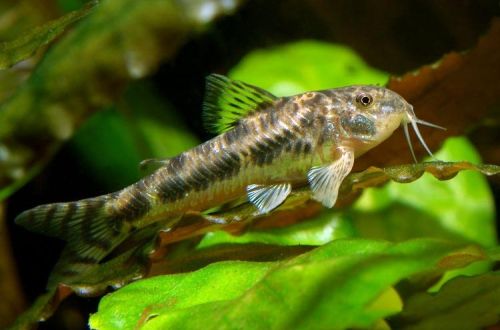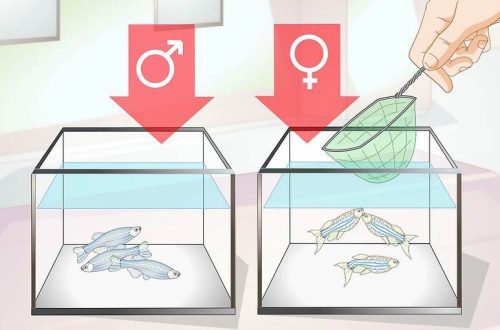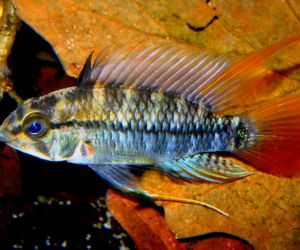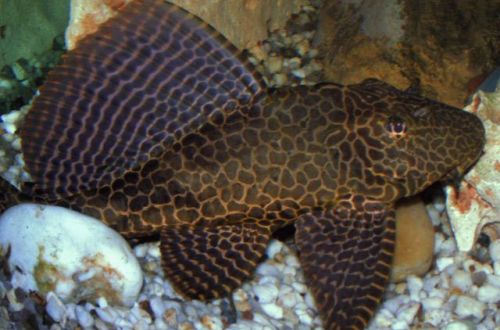
Aspidoras spotted
Aspidoras spotted, scientific name Aspidoras spilotus, belongs to the family Callichthyidae (Shell catfish). Catfish can be considered an excellent choice for a beginner aquarist. It is easy to keep and breed, gets along well with other freshwater fish. The disadvantages include perhaps not a bright color.

Contents
Habitat
It comes from South America from the northeastern part of Brazil. It is found mainly in the state of Ceara in numerous coastal river systems. A typical biotope is the bed of a small shallow stream flowing through the rainforest. The bottom is littered with various snags, remnants of vegetation. The terrain in this region is hilly, so the current is often rough.
Brief information:
- The volume of the aquarium – from 80 liters.
- Temperature – 20-25°C
- Value pH — 6.0–7.5
- Water hardness – 2–12 dGH
- Substrate type – any
- Lighting – any
- Brackish water – no
- Water movement – moderate or strong
- The size of the fish is about 4 cm.
- Food – a variety of sinking foods
- Temperament – peaceful
- Keeping in a group of 4-5 individuals
Description
Adults reach a length of about 4 cm. This group of catfish are close relatives of Corydoras and outwardly very similar to them. The body is covered with hard plates – modified scales, somewhat reminiscent of the armor of a medieval knight. A similar feature is reflected in the scientific name of this group of fish. Aspidoras from Ancient Greek ἀσπίς (aspis) meaning “shield” and δορά (dora) meaning “skin”. On the head, near the mouth, there are three pairs of sensitive antennae, with the help of which the catfish searches for food at the bottom. The color is gray with dark pigmentation. Females grow larger and look more massive, males are noticeably slimmer against their background.
Food
An omnivorous species, in a home aquarium it will accept various foods, preferably sinking ones. Although it can also swim to the surface for a portion of food, the structure of the mouth does not allow it to eat normally in this position – this is a bottom fish.
Maintenance and care, arrangement of the aquarium
the optimal size of the aquarium for a group of 4-5 individuals starts from 60-80 liters. The content of Aspidoras spotted is simple and even beginners can do it. It is not picky about design and is able to live even in a half-empty tank. However, in the presence of large neighbors, it is advisable to provide several shelters so that there is somewhere to hide in case of danger.
Like any other fish that lives in running water in nature, the accumulation of organic waste (food leftovers, excrement) that can upset the biological balance should not be allowed. A stable aquatic environment is achieved through regular aquarium maintenance and installation of the necessary equipment.
Behavior and Compatibility
Peaceful calm catfish, prefers to be in a group of at least 4-5 individuals. It is compatible with many other species, and thanks to its robust armor, is able to get along with some aggressive fish of a similar or slightly larger size.
Breeding / breeding
In nature, spawning is associated with the arrival of the rainy season. Heavy rainfall changes the habitat, which becomes a signal for reproduction. Spotted Aspidoras, available for sale, have been bred in an artificial environment for many generations, during which time they have adapted to reproduce in slightly different external conditions. Nevertheless, it was noted that if the fish are in a suitable environment and receive a balanced diet rich in essential trace elements, then a gradual decrease in water temperature by several degrees and further maintenance of these values serves as an excellent stimulus for spawning. Eggs are attached to any surface (leaves of plants, stones, driftwood), preferring regions where the current is strongest, for example, near filters. Parental instincts are not developed, there is no care for offspring. In order to protect eggs and fry from being eaten, it is advisable to transplant them into a separate tank.
Fish diseases
The cause of most diseases is unsuitable conditions of detention. A stable habitat will be the key to successful keeping. In the event of symptoms of the disease, first of all, the quality of the water should be checked and, if deviations are found, measures should be taken to correct the situation. If symptoms persist or even worsen, medical treatment will be required. Read more about symptoms and treatments in the Aquarium Fish Diseases section.





